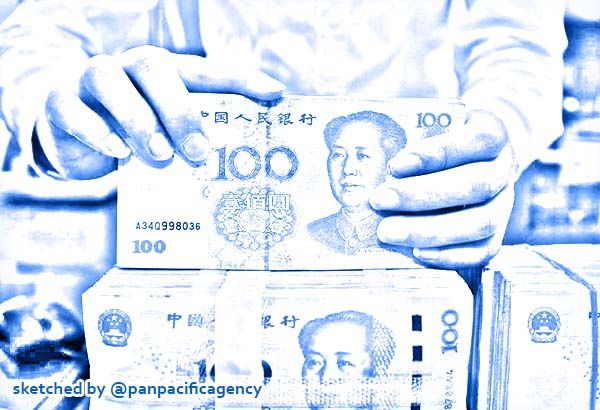China to revive international yuan drive along Belt and Road countries

Yuan (AFP/Getty). Sketched by the Pan Pacific Agency.
BEIJING, Sep 13, 2020, SCMP. China aims to use the yuan “as much as possible” in its Belt and Road Initiative to try to expand its use as a reserve currency, a senior Chinese government adviser said on the weekend, South China Morning Post reported.
Former Chongqing mayor Huang Qifan told a financial forum in Xian in northwestern China on Saturday that the yuan’s share of global payments was limited and the country must redouble efforts to increase the currency’s use in countries that signed up for the massive infrastructure plan.
The yuan accounted for about 2 per cent of global reserves and 1.76 per cent of cross-border payments by the end of June, Huang said, adding: “It’s not commensurate with our country’s status as the world’s largest foreign trade country.”
He said the yuan should be used as much as possible in pricing, settlement, receipts and payments and reserves.
“[China] should accelerate internationalisation of the yuan,” he said.
Beijing has made only limited progress over the last decade in its efforts to expand use of the yuan in international trade and investment in large part because of its firm controls over the capital account.
But the internationalisation drive is taking on fresh urgency as threats of US financial sanctions loom.
Zhang Xiaohui, former assistant governor of the People’s Bank of China, said China should be more aggressive in expanding the yuan’s reach, by signing more bilateral currency swap agreements with other central banks and making foreign donations or loans in yuan.
At the same time, China must reinforce cross-border payment infrastructure and yuan clearing and settlement services, while also reducing reliance on the Belgium-based SWIFT system, she said.
Meanwhile, Huang admitted the belt and road scheme was facing new challenges from the pandemic-induced plunge in international investment and trade.
“In this regard, we need to prepare for long-term changes in the external environment,” he said.
Huang said China’s new inward-facing “dual circulation” strategy, which focuses more on the domestic economy and less on exports, could be a chance to spur belt and road projects.
President Xi Jinping unveiled the strategy in May as a way for China to survive and thrive in an increasingly unstable and hostile world.
Huang said China was willing to share its domestic market with enterprises globally, especially those that could help expand China’s domestic demand and form high-quality industrial chain clusters with Chinese peers.